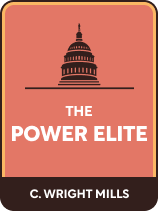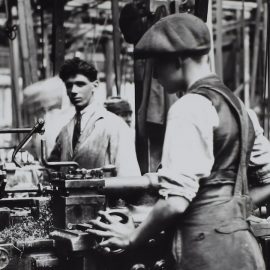

This article is an excerpt from the Shortform book guide to "The Power Elite" by C. Wright Mills. Shortform has the world's best summaries and analyses of books you should be reading.
Like this article? Sign up for a free trial here.
Who really has the power in the United States? How did they get it?
In The Power Elite, C. Wright Mills claims that the United States is controlled by a small group of powerful economic, military, and political elites. Writing in 1956, he suggests that the decisions, failures, and successes of the power elite are what truly determine the course of the country.
Keep reading for an overview of this illuminating book.
The Power Elite by C. Wright Mills
By consolidating wealth and power over time, Mills contends that these “power elites” have exploited American institutions for their own benefit. Now, they’re unaccountable to the people and free to act as immorally as they please. Our overview of The Power Elite by C. Wright Mills explores how this group solidified its rule over the United States as well as how the American people have lost the ability to impact political change.
(Shortform note: To understand Mills’s goal in writing The Power Elite, it helps to understand how he views sociology as a field. In his later work The Sociological Imagination, Mills outlines a theory of sociology as a tool to bridge the gap between history and biography. This means connecting individual circumstances to broader social and political forces—for example, by showing an individual’s high debt was caused in part by systemic economic issues. By making these connections, sociology gives people tools to understand the world around them and ideas for improving it. Through this lens, The Power Elite is Mills’s attempt to connect the development of elite rule to the average American’s feelings of political and economic powerlessness.)
| Critics of Mills’s “Doomsaying” Many critics of The Power Elite and of Mills, in general, argue he has a tendency to overstate or exaggerate in his work, offering dire warnings and predictions. Some dismiss Mills’s work entirely, viewing it as alarmist leftist propaganda lacking academic substance. This is in part because Mills’s conception of a “power elite” is his version of elite theory, a common feature of Marxism and other leftist scholarship. According to elite theory, a few coordinated individuals control a majority of power regardless of democratic elections. Other critics say that while Mills has good ideas, he tends to present them in a too-theatrical or even conspiratorial way. Particularly, critics decry his bold claims about coordination among the power elite, their nefarious goals, and the powerlessness of the American people (which we’ll discuss in Part 2). In the decades since The Power Elite came out, it has become an important part of the American sociological canon. However, some still argue that his work tends toward style over substance, saying Mills angrily criticizes parts of society without offering alternatives. |
Part 1: Defining the Power Elite
According to Mills, the power elite are leaders in business, the military, and politics who have outsized influence on the country.
What truly defines the power elite then is less what they do and more how much influence they have over the economy, politics, and the lives of average Americans.
To elaborate on his definition, Mills emphasizes three aspects of the power elite, which we’ll explore next.
Social Coordination
According to Mills, the power elite is a coordinated class rather than a bunch of disorganized and competing individuals. Besides working together in their professional lives, the power elite have a much deeper level of social integration. Most of the power elite go to the same exclusive preparatory schools and universities and join the same social clubs.
Varying Competence
Mills strongly disagrees with the idea that elites are uniquely competent or intelligent. He notes that many modern elites merely inherit a great deal of their influence. Others who join the power elite do so by getting existing elites to know and trust them.
Money and Power Over Morality
According to Mills, being elite requires a person to emphasize money and power over everything else—moral concerns and values only get in the way. The bureaucratic and corporate structures of the elite allow them to distance themselves from the harm their actions might cause.
Part 2: The Creation of the Power Elite
Mills says this process began after the American Civil War, as political and technological developments allowed businessmen, military generals, and politicians to exercise their influence more broadly. Those who took advantage of these developments gained enough power to shape their respective institutions.
Institution #1: Corporations
Mills starts by discussing how an increasingly small number of corporations influence every aspect of life in America. This is the result of a long process of corporate centralization of wealth and power.
1) Competing to Industrialize
In the decades following the Civil War, Mills says there was intense competition among American corporations. Lax government regulation and corruption allowed larger corporations to buy up or force out smaller competitors. 19th-century industrialists like Andrew Carnegie, John D. Rockefeller, and J.P. Morgan created massive corporations that controlled the steel, oil, and banking industries respectively. As a consequence of these historical developments, writes Mills, the vast majority of any given industry in America is now controlled by five or fewer corporations.
2) Shifting Leadership to Executives
Once industries were dominated by a few major corporations, the intense competition between them slowed down or even stopped altogether, explains Mills. He argues this was because of a shift in corporate leadership from founders to executives and stockholders. Unlike the founders of the past, this new “executive class” was less concerned with the success of their specific corporation and more concerned with the success of their industry and of corporate power in general. Mills suggests two reasons why this is the case:
1) Most executives don’t create or own a majority of their corporations—instead, they’re just hired to run them. This means they don’t have personal incentives to compete.
2) In addition, executives work for multiple corporations over the course of their careers.
3) Defining American Life
Mills explains that, by working together toward their overall interests, the executive class and stockholders have consolidated their power and now dominate major portions of American life. Individual companies or executives can lose power, but the collective power and wealth of corporations remain very stable. They use this power to influence things like what people eat, where they live, the media they watch, and their political lives.
Institution #2: The Military
Mills suggests that, while the United States has been in violent conflict for almost all of its history, the nature of who fights and why they fight has changed drastically in the 20th century. He explains this process in three steps.
1) Using Temporary Militias
Mills explains that, from America’s founding until the 20th century, the military was relatively decentralized and separate from civilian political power. Local militias made up of citizens rather than professional soldiers did a majority of America’s fighting, usually on a small scale.
Even during bigger conflicts like the American Civil War, soldiers and officers were mostly citizens organized into small, decentralized militias. Mills explains that the average general of the late 19th century wasn’t educated, saw plenty of combat firsthand, and rose through the ranks based on performance in battle or seniority as a soldier.
2) Creating the Professional Officer Corps
The next step of American military centralization began at the turn of the 20th century, explains Mills. At this time, the US military started replacing decentralized militias with a professional officer corps. These officers were promoted, not for winning battles or fighting well, but instead for following strict hierarchies and chains of command over the course of their careers.
3) Going to War Indefinitely
The largest growth in military power and influence started a few decades later with World War II. Much like in World War I, the military, civilian government, and private industry worked together during World War II. However, US involvement in the war was much larger.
Most significantly, Mills argues that this collaboration didn’t end after World War II. Instead of dismantling the expanded military and returning to a peacetime economy, the United States entered the Cold War.
Permanent wartime integration allows top generals to gain influence over corporations and politicians alike. Politicians can use the strict hierarchy and obedience of the military to efficiently accomplish their political goals and bypass the democratic political process, meaning they invest more money and power into the hands of the military. Then, generals use the inflated military budget to pour massive amounts of money into private corporations that do business with the military—becoming the largest customer of these companies and gaining a great deal of influence over them.
Institution #3: Civilian Government
Mills argues that federal bureaucratic agencies have slowly gained more and more power than elected officials at every level. This process had three main steps.
1) Using Party Machinery
Mills explains that, before the 20th century, American politicians mainly worked within the political party “patronage” system: Over the course of their careers, they started in local party politics, met party mentors and allies, and received pay-offs and positions of power based on loyalty. This was also true for America’s “civil service,” or government bureaucrats hired for specific technical positions. This system was built on corruption and graft.
2) Growing the Bureaucracy
In the early 20th century, the civil service was dismantled and much of the patronage system of the past was dismantled. This contributed to the centralization of power in two distinct ways:
1) The expansion of the civil service invested more power in federal non-elected positions. New federal agencies within the executive branch had power over major aspects of American life.
2) Reforming the patronage system took wealth and power away from low-level party members.
Reforms of this era cracked down on bribery and graft, but they crucially still allowed elites to control government positions. Mills claims that, despite these reforms, America still doesn’t have a merit-based and apolitical civil service since politicians can create or destroy civil service jobs at will.
3) Appointing Elites
Mills argues that the larger, stronger bureaucratic agencies in the executive branch allow elites to consolidate their power further. He believes these agencies allow elites inside and outside the government to control major American political decisions—things like war and peace, the shape of the economy, and how power is distributed. What the average American sees as politics (elections, Congress, and so on) is actually just a mid-level, intermediary process for determining how to carry out the will of these elite few.
Top bureaucratic positions are often given to corporate and military elites rather than career politicians or bureaucrats—allowing for further integration and centralization of the American power elite.
Part 3: The American People and Power
Mills argues that, due to changes in media and political organization, many Americans feel powerless to influence their political circumstances. Mills suggests that the resulting sense of unease can eventually lead to large-scale political violence.
Let’s look at the three main institutions that define the relationship between the American people and their political circumstances.
Institution #1: The Media
This centralization of media first occurred when new technologies like radio and television made it easier for a few people to reach many, while lax regulation allowed a few major corporations to dominate the media industry. Mills believes that media centralization has taken power away from the American people for two main reasons:
- Fewer opinions—The centralization of media has reduced the number of opinions and viewpoints available to the public.
- Less discussion—Average people are unable to respond to or challenge mass media in meaningful ways.
Institution #2: Political Organizations
Mills argues that American political organizations have also centralized over time, taking power and influence away from the people. Traditionally, an average American could influence local community politics, which then could organize with other communities to influence state and federal politics.
Mills explains that, as the government centralized, these political organizations centralized as well. This is for two main reasons:
- Smaller political organizations are less effective at influencing large, centralized government bureaucracy.
- As electoral politics became less accountable to the people, those wanting to be heard flocked to political organizations, causing them to grow in size.
He suggests that this led to a shift in the structure of organizations: Instead of many autonomous communities coming together to create an organization, a select group of executives and bureaucrats now control massive national volunteer organizations. Members of these groups are as disconnected from real power as they are in politics.
Institution #3: The Intellectual Class
Mills argues that, traditionally, intellectuals in America served to challenge or explain political dynamics to the American people. However, Mills claims that this is no longer the case. He suggests that the majority of American intellectuals fail to acknowledge, question, or challenge the rule of the power elite. This has also taken power away from the American people by depriving them of their ability to understand what’s going on in government.
According to Mills, both post-war conservatives and post-war liberals fail to acknowledge the power elite.
1) Conservatives
Conservative politicians and intellectuals channel middle-class frustrations into attacks on specific individuals, institutions, and symbols of status within government. The most obvious example of this sort of behavior at the time is a campaign of unfounded personal attacks and accusations led by Wisconsin senator Joseph McCarthy in the 1950s.
2) Liberals
Mills suggests that, instead of acknowledging or challenging the rule of the power elite, post-war American liberals are attempting to mount a disorganized defense of the status quo. This is because liberals held power for decades before World War II, leading to two main consequences:
- The liberal grassroots organization has greatly diminished.
- The New Deal made a significant portion of liberal political projects into federal law.
Finally, Mills claims that, as an ideology, liberalism in post-war America has essentially become meaningless. Liberal ideals—a government of the people, limits on government power, freedom of political expression, and so on—are frequently used in the rhetoric of both liberals and conservatives to justify vastly different policies. In the meantime, neither group actually tries to fight for these ideals.

———End of Preview———
Like what you just read? Read the rest of the world's best book summary and analysis of C. Wright Mills's "The Power Elite" at Shortform.
Here's what you'll find in our full The Power Elite summary:
- How a group of corporate elite controls America's politics and economics
- How the elite exploit America's institutions for their own benefit
- A look at the dangers that arise when citizens feel powerless






